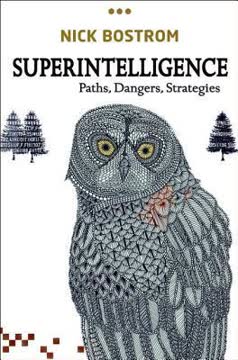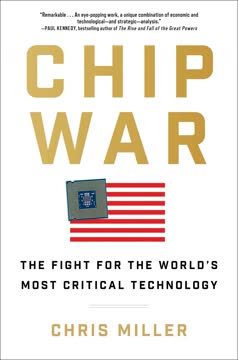Key Takeaways
1. AI's rapid evolution demands immediate global attention and action
"Whoever becomes the leader in this sphere will become the ruler of the world."
Global AI race. Vladimir Putin's 2017 statement about AI leadership sparked intensified global competition in artificial intelligence development. This technological arms race has profound implications for economic, political, and military power. Nations are investing heavily in AI research and development, recognizing its potential to reshape industries, warfare, and global influence.
Urgent need for action. The rapid pace of AI advancement necessitates immediate attention from policymakers, industry leaders, and citizens. Key areas requiring focus include:
- Ethical guidelines for AI development and deployment
- International cooperation and standards
- Education and workforce preparation for an AI-driven economy
- Addressing potential job displacement and economic disruption
- Ensuring AI benefits all of humanity, not just select nations or corporations
2. The history of computing laid the groundwork for modern AI capabilities
"Even the most advanced computers of today are far less capable, complex, and wondrous than the human brain."
Foundations of computing. The development of modern AI builds upon decades of progress in computing technology. Key milestones include:
- Alan Turing's work on computational theory and the Turing Test
- The development of early computers like ENIAC
- Advances in transistor technology and integrated circuits
- The creation of the internet and world wide web
From calculation to cognition. Early computers excelled at rapid calculations but lacked the ability to learn or adapt. The evolution from deterministic programming to machine learning algorithms marked a crucial shift towards artificial intelligence. This transition enabled computers to find patterns and make predictions from data, mimicking aspects of human cognition.
3. Machine learning enables AI to find patterns and make predictions from vast data
"Data is the equivalent of experience."
Data-driven intelligence. Machine learning algorithms allow computers to improve their performance on tasks through exposure to data, without explicit programming. This approach enables AI systems to:
- Recognize patterns in complex datasets
- Make predictions based on historical information
- Adapt to new situations and improve over time
Types of machine learning. The field encompasses various approaches:
- Supervised learning: Training on labeled data
- Unsupervised learning: Finding patterns in unlabeled data
- Reinforcement learning: Learning through trial and error
- Deep learning: Using artificial neural networks to process information in layers
4. Narrow AI excels in specific tasks but lacks general intelligence
"Narrow AI is very strong, efficient, and quite capable at its purposed job. It's just incompetent at anything beyond it."
Specialized intelligence. Current AI systems are designed for specific tasks and lack the general intelligence of humans. Examples of narrow AI include:
- Image and speech recognition
- Natural language processing
- Game-playing algorithms (e.g., DeepMind's AlphaGo)
- Recommendation systems
Limitations of narrow AI. While highly effective in their domains, these systems cannot transfer knowledge or skills to unrelated tasks. They lack:
- Common sense reasoning
- Emotional intelligence
- Creativity and abstract thinking
- Consciousness and self-awareness
5. AI applications are reshaping industries and daily life worldwide
"More than 90 percent of all data available in the world has been generated in just the last few years alone."
Pervasive impact. AI is transforming numerous sectors:
- Healthcare: Disease diagnosis, drug discovery, personalized medicine
- Finance: Algorithmic trading, fraud detection, risk assessment
- Transportation: Self-driving vehicles, traffic optimization
- Manufacturing: Robotic automation, predictive maintenance
- Retail: Personalized recommendations, inventory management
- Education: Adaptive learning platforms, automated grading
Data-driven society. The proliferation of AI is both enabled by and contributing to the massive growth in data generation and collection. This data deluge raises concerns about:
- Privacy and data protection
- Algorithmic bias and fairness
- The concentration of power in tech giants
- The digital divide between data-rich and data-poor regions
6. China and Russia pursue AI strategies aligned with authoritarian governance
"AI is a disruptive technology with widespread influence that may cause: transformation of employment structures; impact on legal and social theories; violations of personal privacy; challenges in international relations and norms; and other problems."
China's AI ambitions. The Chinese government has outlined a comprehensive strategy to become the global leader in AI by 2030. Key aspects include:
- Massive investments in AI research and development
- Integration of AI into surveillance and social control systems
- Export of AI-enabled technologies to expand global influence
Russia's focus. While lacking China's resources, Russia is pursuing AI development with an emphasis on:
- Military applications and autonomous weapons systems
- Information warfare and disinformation campaigns
- Cyber operations and espionage
Authoritarian AI. Both nations are leveraging AI to strengthen authoritarian control, raising concerns about:
- Mass surveillance and social credit systems
- Suppression of dissent and free speech
- Erosion of individual privacy and autonomy
7. Democratic nations must unite to ensure AI aligns with human rights and freedoms
"Separate and together, democracies must work to ensure that AI is developed and implemented only in ways that ensure the rights and freedoms to which their citizens are fundamentally entitled . . . and that protect their citizens from all contrary uses, whether domestic or foreign."
Collaborative approach. Democratic nations need to:
- Develop shared ethical guidelines for AI development
- Invest in AI research aligned with democratic values
- Create international frameworks for AI governance
- Foster public-private partnerships to drive innovation
Balancing innovation and regulation. Democracies face the challenge of promoting AI advancement while safeguarding individual rights. Key considerations include:
- Data privacy and protection laws
- Algorithmic transparency and accountability
- Mitigating job displacement and economic inequality
- Ensuring AI benefits all segments of society
8. Ethical AI development requires diverse perspectives and ongoing vigilance
"Our job is now to convince the public in particular that using AI to achieve these aims is a necessary and desirable part of our society, but we cannot afford to do so unless we know how it will best be used and when."
Multidisciplinary approach. Ethical AI development necessitates input from:
- Computer scientists and AI researchers
- Ethicists and philosophers
- Legal experts and policymakers
- Social scientists and humanists
- Representatives from diverse communities
Ongoing challenges. Key ethical issues in AI include:
- Bias and fairness in AI systems
- Transparency and explainability of algorithms
- Accountability for AI-driven decisions
- The impact of AI on employment and economic inequality
- Long-term existential risks of advanced AI
Public engagement. Fostering an informed citizenry is crucial for the responsible development of AI. This requires:
- Improved AI literacy in education and public discourse
- Open dialogue about the societal implications of AI
- Mechanisms for public input on AI policies and regulations
- Continuous reassessment of AI's impact as the technology evolves
Last updated:
FAQ
What's T-Minus AI about?
- AI's Impact on Society: T-Minus AI explores how artificial intelligence is transforming various aspects of human life, including societal structures and global power dynamics.
- Historical Context: Michael Kanaan provides a historical overview of AI, comparing its evolution to past technological revolutions like the printing press and the internet.
- Global Cooperation: The book emphasizes the need for international agreements to ensure AI is used ethically and to mitigate potential risks.
Why should I read T-Minus AI?
- Comprehensive Overview: The book offers a thorough examination of AI, making complex concepts accessible to readers without a technical background.
- Timely Relevance: As AI continues to evolve, understanding its implications is crucial for anyone interested in technology's future role in society.
- Expert Insights: Kanaan draws on his experience and includes perspectives from various experts, adding depth and credibility to the discussions.
What are the key takeaways of T-Minus AI?
- AI as a Double-Edged Sword: AI can be both beneficial and harmful, depending on its application, and understanding its potential is crucial.
- Need for Ethical Guidelines: Establishing ethical frameworks and international agreements is essential to ensure AI technologies are used responsibly.
- Cultural Context Matters: Different nations approach AI development based on their cultural values, leading to diverse outcomes.
What are the best quotes from T-Minus AI and what do they mean?
- Global Stakes in AI: "Artificial intelligence is the future, not only for Russia, but for all humankind." This highlights AI's potential to reshape global power dynamics.
- Dual Nature of AI: "AI may be a blessing, but it can also be the ultimate curse." This serves as a warning about the risks of mismanaged AI.
- Need for Common Understanding: "We must have a common understanding of AI." This emphasizes the importance of collective dialogue and education about AI.
How does T-Minus AI address the ethical implications of AI?
- Call for Accountability: Kanaan stresses the need for accountability in AI systems to prevent biases and discrimination.
- Cultural Sensitivity: Ethical considerations must account for cultural differences in values and norms, advocating for inclusive dialogue.
- Regulatory Frameworks: Governments should establish guidelines to ensure AI technologies align with democratic values and human rights.
What is the historical evolution of AI discussed in T-Minus AI?
- Early Beginnings: AI's roots trace back to the 1960s, with initial progress often facing setbacks known as "AI winters."
- Recent Breakthroughs: Significant advancements in machine learning over the last 10 to 15 years have renewed interest and investment in AI.
- Geopolitical Implications: AI's evolution is linked to current geopolitical tensions, particularly between the U.S., China, and Russia.
What are the different types of AI discussed in T-Minus AI?
- Narrow AI: Most current applications are "narrow AI," designed for specific tasks but lacking general intelligence.
- General AI: This concept involves AI performing any intellectual task a human can do, but it remains far from realization.
- Superintelligence: A theoretical idea where AI surpasses human intelligence across all domains, still speculative and not an immediate concern.
What are the potential risks of AI discussed in T-Minus AI?
- Military Applications: AI could be weaponized, leading to new forms of warfare and conflict, raising ethical and safety concerns.
- Social Manipulation: AI can manipulate public opinion and behavior through targeted misinformation, undermining democratic processes.
- Economic Displacement: AI may disrupt job markets and economies, necessitating proactive measures to address these challenges.
How does T-Minus AI suggest we prepare for the future of AI?
- Education and Awareness: Educating the public about AI and its implications is crucial for informed engagement in policy discussions.
- Collaborative Efforts: Governments, industries, and academia should collaborate to develop responsible AI frameworks.
- Proactive Policy Development: Creating policies that anticipate AI's societal impacts can help mitigate risks and maximize benefits.
What role does data play in AI as discussed in T-Minus AI?
- Foundation of AI: Data is the essential building block for AI systems, enabling learning, analysis, and predictions.
- Quality of Data: High-quality, unbiased data is crucial for effective AI training, as poor data can lead to flawed algorithms.
- Data Privacy Concerns: Ethical implications of data collection and usage, particularly regarding privacy, are addressed, advocating for responsible practices.
How does T-Minus AI compare AI to past technological revolutions?
- Historical Parallels: The AI revolution is compared to past innovations like the printing press and the internet, highlighting its transformative potential.
- Lessons Learned: Understanding the historical context of technological advancements can provide insights into managing AI's impact.
- Future Implications: AI could lead to significant societal changes, underscoring the importance of proactive engagement with AI technologies.
What is the significance of the "Sputnik moment" in T-Minus AI?
- Historical Context: The "Sputnik moment" describes critical junctures when nations realize the need to respond urgently to technological advancements.
- Call to Action: It signifies the urgency for democratic nations to engage with AI technologies proactively to avoid geopolitical disadvantages.
- Collective Responsibility: Addressing AI challenges is a collective responsibility, requiring nations to work together to align AI with democratic values and human rights.
Review Summary
T-Minus AI by Michael Kanaan offers an accessible introduction to artificial intelligence, exploring its history, current applications, and geopolitical implications. Readers appreciate Kanaan's ability to explain complex concepts simply, though some find the book's breadth overwhelming. The book is praised for its insights into AI's impact on global relations, particularly regarding China and Russia. While some criticize its lack of technical depth, others value its broad perspective. Overall, it's considered a solid primer for those new to AI, though opinions vary on its effectiveness for more knowledgeable readers.
Similar Books










Download PDF
Download EPUB
.epub digital book format is ideal for reading ebooks on phones, tablets, and e-readers.




